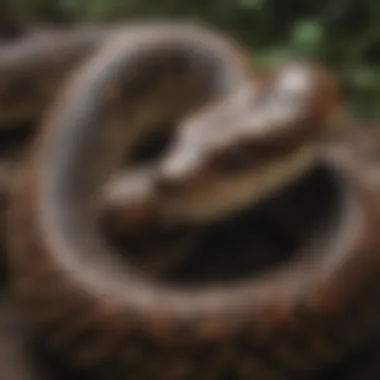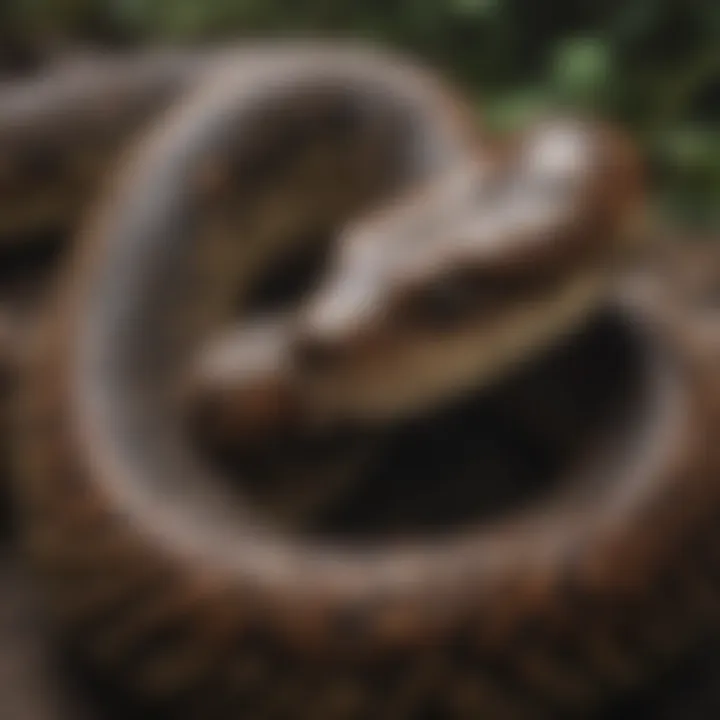Top Ten Most Venomous Snakes: An In-Depth Analysis


Intro
Venomous snakes command fear and fascination in equal measure. They are often misunderstood, seen as purely dangerous creatures. However, their venom serves various ecological purposes. Understanding these snakes provides insights not only into the dangers they present but also into their roles in maintaining biodiversity.
This article will explore the top ten most venomous snakes in the world, examining their classifications, habitats, behaviors, and the real threats they pose to humans. By gaining a comprehensive understanding of these species, we can better appreciate their ecological importance and learn how to prevent and treat snake bites.
Key Concepts
Definition of Primary Terms
Venomous Snake: A snake that has specialized glands and associated structures which produce venom, used primarily to subdue prey. Venom can also serve as a defense mechanism.
Ecological Role: Refers to the function that an organism plays within its ecosystem, including how it interacts with other species and influences the environment.
Related Concepts and Theories
The study of venomous snakes extends into several interdisciplinary fields. One key area is toxicology, which examines the effects of venom on living organisms. Another important concept is ecology, which focuses on the relationships between organisms and their environment. Additionally, conservation biology addresses the threats faced by these snakes due to habitat loss, climate change, and human activities.
Future Directions
Gaps Identified in Current Research
Despite existing studies, gaps persist in understanding how climate change specifically affects venomous snake populations and their behavior. Furthermore, the biochemical properties of snake venom and their potential medicinal applications remain largely unexplored.
Suggestions for Further Studies
Future research could focus on long-term monitoring of venomous snake habitats to assess changes over time. Investigations into the synergistic effects of venom from different species could also provide valuable insights. Another area for exploration might involve community-based education initiatives on snakebite prevention, enhancing public knowledge and safety.
"A thorough understanding of these snakes informs us not just about their biology but also their significance in the ecosystems they inhabit."
Prelims to Venomous Snakes
Understanding venomous snakes is crucial for several reasons, particularly their impact on ecosystems and human safety. This section introduces the complexities of venom, offering a basis for exploring various snake species scientifically and socially.
Definition of Venom
Venom is a specialized type of saliva that contains enzymes and toxins. It is injected into the victim through bites or stings. This adaptation aids in hunting and self-defense. Venom can disrupt physiological processes in prey, leading to paralysis, tissue damage, or death. Vipers, cobras, and many others possess this potent biological weapon. Each type of venom serves different purposes depending on the snake's habitat and hunting strategies. For researchers and physicians, distinguishing between venoms is essential. By studying these toxins, scientists can develop antivenins to treat snakebites effectively.
Importance of Studying Venomous Snakes
Studying venomous snakes offers insights into biodiversity, evolution, and ecology. These snakes often play critical roles in their habitats, helping to maintain ecological balance. For instance, their predation influences the population of various species, thus shaping food webs. Additionally, understanding their behaviors aids in mitigating risks to humans.
Knowledge of venom composition has led to medical advancements. Toxins from certain snakes are being researched for their potential in pharmaceuticals. For example, some components can aid in blood thinning and pain management.
Given the growing urbanization and habitat destruction, the necessity of studying venomous species increases. Such research can help advocate for conservation efforts, as many species face declining populations.
"The only way to effectively mitigate the risk posed by venomous snakes is through understanding their biology and ecology."
Classification of Venomous Snakes
Understanding the classification of venomous snakes is crucial in any comprehensive study of their biology and ecology. It allows researchers and enthusiasts alike to organize diverse species into a coherent framework based on shared characteristics. This classification goes beyond mere nomenclature; it helps delineate the various adaptations that contribute to their venomous nature.
The importance of classification is highlighted by the insight it provides into evolutionary relationships. For instance, knowing whether a snake belongs to the Elapidae family or the Viperidae family aids in predicting its venom type, method of subduing prey, and behavior patterns. The ecological roles of different families also become clearer. Venomous snakes are not merely agents of danger; they play significant roles in controlling pest populations and shaping their ecosystems. Understanding these dynamics helps inform conservation strategies and public health initiatives.
Families of Venomous Snakes
Venomous snakes can be primarily divided into several families. The two most notable families are Elapidae and Viperidae. Each family has distinct characteristics, adaptations, and ecological niches, making them fascinating subjects for study.
- Elapidae: Members of this family include well-known snakes such as the cobra and the black mamba. They possess neurotoxic venom, which affects the nervous system, leading to paralysis. Elapids are generally characterized by their slender bodies and fixed fangs that deliver venom deep into their prey.
- Viperidae: This family includes rattlesnakes and pit vipers. Viperids are known for their hemotoxic venom, which can cause tissue damage and disrupt blood clotting. They typically have long, hinged fangs that allow for deep penetration into their prey. Their stout bodies allow for ambush predation, often using camouflage as a strategy.
The differences in venom composition and fangs type between these families reflect tailored evolutionary strategies for survival and hunting.
Differences Between Elapidae and Viperidae
Elapidae and Viperidae, while both venomous, exhibit key differences that impact their hunting styles and ecological functions. Comparing these two families highlights how diversification in venomous snakes has evolved.
- Venom Composition: Elapidae typically produce neurotoxins, while Viperidae produce hemotoxins. This difference dictates the type of injuries each family inflicts on their prey.
- Fang Structure: Elapids have fixed fangs situated at the front of their mouths, ideal for injecting venom quickly and efficiently. In contrast, vipers have long, retractable fangs that allow them to strike and inject venom deeply into the target.
- Behavioral Patterns: Elapids often exhibit speed and agility during attacks. Vipers, on the other hand, employ a more ambush-based strategy, relying on camouflage to surprise their prey.
In summary, understanding the classification of venomous snakes and the differences between their families enhances our knowledge about their biology and ecological roles. This classification serves as a foundation for further studies in venom research, conservation efforts, and public safety awareness regarding snakebites.
"The organization of venomous snakes into classification families not only simplifies study but also reveals the complex evolutionary strategies that enable their survival in diverse ecosystems."
The insights gained from studying these classifications not only inform ecological understanding but also guide conservation policies that are critical in the fight to protect these essential species.
The Top Ten Venomous Snakes
Understanding the top ten venomous snakes is crucial for both ecological study and public safety. This section highlights key characteristics of these snakes, focusing on their habitats, venom potency, and interactions with humans. Knowing about these snakes helps in awareness and education concerning venomous species, which is vital for those living in or visiting regions where these snakes are prevalent.


The meticulous examination of each snake sheds light on its unique adaptations, survival strategies, and the roles they play in their ecosystems. This knowledge informs conservation strategies, emphasizes the need for respect towards wildlife, and promotes informed behavior in snake-prone areas.
Overview of the List
The selection of these ten snakes is based on various factors including venom toxicity, geographic distribution, and potential danger to humans. These snakes not only represent the extremes of venomous adaptations but also serve as indicators of ecosystem health. Understanding the ecological roles of each snake provides insight into their behaviors, mating habits, and hunting strategies.
Inland Taipan
Habitat and Range
The Inland Taipan, also known as the fierce snake, is native to arid regions of Australia. It inhabits the black soil plains, which offer a unique microhabitat. This snake prefers the warmth and has a preference for areas with low vegetation. This habitat is beneficial for controlling its prey, particularly rodents, which are abundant in these locations. Understanding the habitat and range of the Inland Taipan is important. It showcases the adaptability of venomous snakes to thrive in less hospitable environments.
Venom Characteristics
The venom of the Inland Taipan is highly neurotoxic, making it one of the most potent in the world. Its primary action is on the nervous system of its prey. This characteristic aids in rapid incapacitation of its meals. The specific makeup of proteins in its venom can neutralize a mouse within minutes. Such venom characteristics justify the fascination and fear of this snake, positioning it as a top subject for both research and public awareness.
Human Interaction
Human encounters with the Inland Taipan are rare due to its isolated habitat. However, when interactions occur, they can lead to severe consequences. The snake is known for its reclusive behavior, avoiding confrontation. Despite its potential danger, there have been few recorded fatalities, often due to effective medical treatments available today. Understanding these interactions is essential for developing safety strategies in areas where the snake may appear.
Black Mamba
Habitat and Range
The Black Mamba is found primarily in the woodlands and savannas of sub-Saharan Africa. This snake prefers regions with ample cover, allowing it to ambush prey effectively. Its habitat choice reflects its hunting style, which relies on speed and stealth. Understanding its range helps in identifying areas where humans are most likely to encounter this dangerous snake.
Venom Characteristics
The venom of the Black Mamba can be extremely lethal, comprising potent neurotoxins. Its venom not only causes paralysis but also affects the heart. The rapid action of the venom underscores the snake's reputation as one of the quickest to deliver a fatal bite. This characteristic is important when discussing the implications of snakebites and the urgency of medical intervention.
Human Interaction
Human interaction with the Black Mamba can result in serious consequences. Its aggressive defense behavior makes it particularly dangerous when provoked. Awareness of proper behavior around this snake is vital. Many native peoples have developed cultural narratives surrounding the Black Mamba to educate and warn about its risks.
King Cobra
Habitat and Range
The King Cobra is predominantly found in forests or jungles across Southeast Asia. This snake favors humid, warm regions near water sources. Understanding its habitat is crucial for recognizing where it might overlap with human activities. The habitat supports its role as a top predator in its ecosystem.
Venom Characteristics
The venom of the King Cobra is both potent and complex. It can cause respiratory failure in its prey. Unlike many snakes, the King Cobra can deliver a large volume of venom in a single bite. This characteristic makes it critically important in discussions about snakebite management and antivenom production.
Human Interaction
Interactions between humans and King Cobras are often dramatic. These snakes are known to react defensively if threatened. Fatalities are infrequent but can occur without prompt medical attention. Educating the public about the behavior and habitat of King Cobras can enhance mutual respect and reduce conflicts.
Many-Banded Krait
Habitat and Range
The Many-Banded Krait is found in regions ranging from India to Southeast Asia. This snake typically inhabits rice paddies and forest edges, thriving in agricultural settings. Its choice of habitat brings it into closer contact with humans, increasing the likelihood of encounters. Knowing this can inform locals about precautionary measures.
Venom Characteristics
Venom of the Many-Banded Krait is a strong neurotoxin that affects the body's nervous system. Its venom causes serious health complications, including paralysis and respiratory failure. Highlighting these venom characteristics is significant to underscore the need for education about snakebite risks in affected communities.
Human Interaction
Many-Banded Kraits are nocturnal, which influences human interactions. Bites often occur when people are unaware. Despite its venom potency, bites can often lead to mortality due to lack of immediate medical care. Public awareness is crucial for reducing snakebite incidences.
Tiger Snake
Habitat and Range
Tiger Snakes are broadly distributed along the southern coast of Australia. They thrive in coastal and wetland regions, reflecting their adaptability to various environments. Their presence in populated areas raises concerns regarding human-snake encounters. Understanding their habitat helps create awareness about the need for caution.
Venom Characteristics
The venom features a complex profile, boasting both neurotoxic and hemotoxic properties. This dual-action venom allows for a rapid incapacitation of prey. Assessing these venom characteristics is essential in discussing the implications for human health after a bite.
Human Interaction
Tiger Snakes are known for highly aggressive behavior, particularly when threatened. They often inhabit areas frequented by people. Therefore, knowledge about their behavior is vital for safe coexistence, ensuring encounters are minimized.
Banded Sea Snake
Habitat and Range


The Banded Sea Snake is typically found in the warm waters around the coasts of the Indian and Pacific Oceans. These sea snakes tend to inhabit coral reefs, which provide both shelter and hunting grounds. Their aquatic nature brings unique challenges regarding conservation and human interaction.
Venom Characteristics
The venom of the Banded Sea Snake is strong enough to affect small fish. However, its effect on humans is less commonly lethal, primarily due to its nature of avoiding confrontation. This aspect of its venom profile is important when discussing the relative risks of sea snake bites.
Human Interaction
Interactions with humans are generally rare, as these snakes prefer to avoid areas with high foot traffic. Nevertheless, their presence in fishing areas can lead to accidental encounters. Educating fishermen about safe practices around Banded Sea Snakes contributes to safer interactions.
Fer-de-Lance
Habitat and Range
The Fer-de-Lance snake is commonly found in Central and South America. It prefers forested areas but can also adapt to human-altered landscapes. Its adaptability signifies both ecological resilience and potential danger in human-inhabited regions.
Venom Characteristics
The fer-de-lance has a highly complex venom that causes local tissue necrosis. Its dual action affects both the cardiovascular and nervous systems of its prey. Understanding these venom intricacies is critical for addressing snakebite treatment methodologies.
Human Interaction
This snake's proximity to human settlements results in frequent encounters, often with serious consequences. Human activities in its habitat increase risks of bites. Awareness and risk mitigation strategies are essential for communities near their range.
Gaboon Viper
Habitat and Range
The Gaboon Viper is chiefly found in the rainforests of Central and West Africa. It favors habitats with thick vegetation and humidity. Its camouflaging ability serves a dual role in predation and evasion tactics which make understanding its habitat crucial for both ecological and safety considerations.
Venom Characteristics
The venom of the Gaboon Viper is rich in hemotoxins. It has a slower onset but is extremely destructive, affecting blood and tissue health. Its potent venom highlights the need for clear educational efforts about its lethality following a bite.
Human Interaction
Human encounters with the Gaboon Viper can be dangerous due to its camouflage. Often, people walk over or near this snake without recognizing it until too late. Insight into behavior and habitats improves public understanding and mitigates risks of accidental bites.
Puff Adder
Habitat and Range
The Puff Adder prefers savannas and grasslands in Sub-Saharan Africa, allowing it to blend into its environment effectively. Its preference for open areas near bush provides ample cover for ambush hunting. Understanding its distribution is important for assessing risk areas in human activities.
Venom Characteristics
The venom is cytotoxic, causing significant tissue damage upon envenomation. While not as potent as some other snake venoms, the Puff Adder's strike frequency compensates. Highlighting this characteristic is important for understanding management protocols post-bite.
Human Interaction
Puff Adders often come into contact with people, leading to a considerable number of bites each year. Their tendency to remain still when threatened can increase encounter rates. Education and preventive measures are essential for minimizing risks in areas where this snake is found.
Eastern Brown Snake
Habitat and Range
Eastern Brown Snakes inhabit a variety of environments, from woodlands to urban areas in Australia. This adaptability to both natural and disturbed environments increases the likelihood of human encounters. Recognizing its range is pivotal for mitigating risks associated with urbanization and snake presence.
Venom Characteristics
Its venom is exceptionally toxic, causing paralysis and coagulopathy. As one of the most venomous snakes, the Eastern Brown's characteristics necessitate prompt medical attention after bites. Understanding these properties is essential for developing effective treatment strategies.
Human Interaction
The Eastern Brown Snake is known for its defensive behavior and rapid movement. These traits can lead to high levels of anxiety among people in areas where they reside. Education on safe practices when encountering this snake is crucial for reducing fatalities.
Effects of Venom on Humans
Understanding the effects of venom on humans is crucial in the study of venomous snakes. This section illuminates the ways in which their venom can affect humans biologically and psychologically. It draws connections between this knowledge and practical measures that can be taken to prevent and treat snake bites. Awareness of these aspects can significantly contribute to public safety, improve medical responses, and foster respect for these reptiles within their ecosystems.
Types of Snake Venom
Snake venom can be categorized into several types, each with unique compositions and effects. The primary venom types are neurotoxic, hemotoxic, and cytotoxic:
- Neurotoxic Venom: This type affects the nervous system. It interrupts communication between nerves and muscles, leading to paralysis. For instance, the Black Mamba possesses neurotoxic venom that can cause respiratory failure in humans within hours if untreated.
- Hemotoxic Venom: This venom affects the circulatory system. It can damage blood cells and tissues, causing extensive internal bleeding. The Fer-de-Lance is known for its hemotoxic venom that can result in shock and severe tissue damage.
- Cytotoxic Venom: This type destroys cells and can cause necrosis. The Gaboon Viper is an example of a snake with cytotoxic venom, which may result in the severe decay of affected tissues.
Understanding these categories helps in predicting the potential effects of snake bites and preparing appropriate medical treatments.
Symptoms of Snakebites


Symptoms of a snakebite can vary significantly depending on the type of venom and the individual’s reaction. Common symptoms to be aware of include:
- Pain and Swelling: Initial puncture wounds often lead to localized pain and swelling that can spread.
- Discoloration: Bruising or a change in skin color may occur, indicating tissue damage.
- Nausea and Vomiting: Some victims experience gastrointestinal symptoms.
- Neurological Changes: In cases of neurotoxic venom, affected individuals may show signs of paralysis, slurred speech, or confusion.
It is essential to recognize these symptoms early, as timely medical attention is often critical in mitigating the dangers of envenomation.
Treatment Options
Effective treatment for snakebites is fundamentally about rapid response to mitigate venom effects. Key treatment options include:
- Immediate Medical Care: It is vital for anyone bitten by a venomous snake to seek medical attention promptly. Emergency services can provide crucial care quickly.
- Antivenom Administration: This is often the primary treatment. Antivenoms are derived from the immune responses of other animals and can neutralize the venom.
- Supportive Care: While waiting for advanced treatment, providing supportive measures such as immobilizing the affected limb or keeping the victim calm can help.
- Surgical Intervention: In some severe cases, surgical procedures may be necessary to remove damaged tissue or correct structural injuries resulting from the bite.
"Knowing the treatment options can mean the difference between life and death in the case of venomous snakebites."
Each of these options is based on the type of venom involved, reinforcing the need for accurate identification of the snake involved in the incident.
In summary, understanding the effects of venom on humans involves recognizing the types of venom, symptoms of bites, and available treatments. This knowledge arms individuals with the information necessary to respond to snakebite emergencies effectively.
Ecological Roles of Venomous Snakes
Venomous snakes play a crucial role in their ecosystems. They not only affect the populations of their prey but also influence the behaviors of other predators. Understanding the ecological significance of these snakes is vital for recognizing their contributions to biodiversity.
Predation and Food Webs
Venomous snakes are key players in the food webs of various environments. They primarily hunt small to medium-sized animals, such as rodents or amphibians, using their venom for immobilization. For example, the Inland Taipan's venom can quickly paralyze its prey, making it easier to consume.
These snakes help maintain the balance within their ecosystems. By preying on abundant species, they prevent population booms that could lead to resource depletion. This is especially significant in ecosystems where rapid reproduction of certain species can have severe impacts. Without the predation from venomous snakes, some populations could grow unchecked.
Additionally, venomous snakes also serve as prey for larger animals. Eagles, hawks, and some mammals have adapted to hunt and eat snakes. Their presence in the food web adds depth to the ecological interactions taking place.
Venom as a Survival Mechanism
The venom of snakes is a remarkable evolutionary adaptation. It serves multiple purposes beyond predation. First, venom protects snakes from threats. The ability to deliver a quick and potent bite can deter potential predators. For instance, the Black Mamba is known for both its speed and lethal venom, which enhance its survival prospects in the wild.
Moreover, venomous snakes can also employ their venom for self-defense. This mechanism becomes crucial in habitats with many competing species. Knowing how to effectively use venom can mean the difference between life and death.
Venom has also been studied for its potential medical applications. Researchers are examining snake venom's components for pain management and cancer treatment. This indicates how studying these snakes can lead to beneficial discoveries for humanity.
Understanding these ecological roles enhances our appreciation for these often-misunderstood creatures and underscores the need for their conservation.
Conservation Challenges
Conservation challenges related to venomous snakes are increasingly critical as these species face a precarious existence amid human activities and environmental changes. Understanding these challenges is essential for fostering awareness and driving efforts aimed at maintaining the delicate balance of ecosystems.
Venomous snakes, which play a significant role in maintaining the health of their environments, are threatened by several factors. Habitat destruction is one of the foremost concerns. As urban areas expand and agriculture intensifies, snakes lose their natural habitats, affecting their populations significantly. The decline in prey species due to habitat loss can also lead to their starvation.
Additionally, snakes are victims of human persecution. Fear and misunderstanding lead to often fatal encounters between humans and snakes. Many venomous snakes are killed when spotted, regardless of whether they pose a real threat. This is compounded by the impact of climate change, which disrupts their habitats and can lead to shifts in behavior and distribution patterns.
Moreover, the illegal wildlife trade poses severe risks. Certain species are harvested for their skin or fangs, sometimes driving them toward extinction. The loss of such keystone species disrupts food webs and undermines ecosystem resilience.
"Conservation of venomous snakes is not just about saving a species; it's about preserving entire ecosystems that rely on their presence."
Threats to Venomous Snakes
The threats to venomous snakes can be categorized into several key areas:
- Habitat Loss: Urbanization and agriculture lead to less available territory, restricting their natural behaviors and reproduction.
- Climate Change: Temperature shifts can alter their habitats and food sources, creating challenges for adaptation.
- Human Conflict: Fear and misconceptions about venomous snakes lead to their indiscriminate killing.
- Wildlife Trade: Poaching for skins, fangs, or even as exotic pets contributes to declining populations.
- Pollution: Pesticides and other chemicals threaten both their prey and the snakes themselves, impacting reproductive health and survival.
Confronting these interactions is vital for creating effective conservation strategies and ensuring the survival of venomous snakes and the ecosystems they inhabit.
Importance of Conservation Efforts
Conservation efforts play a key role in ensuring the survival of venomous snakes and maintaining ecological integrity. Protecting these species is essential for several reasons. Firstly, they contribute to controlling rodent populations, thus preventing the spread of diseases. Moreover, their venom has significant medical potential, offering avenues for research in pharmacology and toxicology.
Implementing conservation strategies, such as habitat restoration and legal protections, can lead to population stability. Additionally, educational programs can alter public perception, reducing the fear that often translates to persecution. Raising awareness regarding the importance of these snakes—both ecologically and scientifically—can promote a more informed approach to their existence.
Involvement from local communities is crucial. Initiatives that engage residents often yield successful results, as communities become stakeholders in the conservation processes. By fostering a connection between people and wildlife, it is possible to create a more sustainable coexistence.
Ending
The conclusion of this article serves as a crucial element in synthesizing the in-depth exploration of the top ten venomous snakes. In this section, we spotlight the salient findings discussed throughout the text, emphasizing their significance within the broader context of both ecology and human interaction. These snakes are not merely subjects of curiosity; they play vital roles in their ecosystems and contribute to the balance of their environments. Acknowledging their value can reshape our understanding of wildlife and encourage protective measures.
Summation of Findings
In summation, the analysis presented illustrates the complexity and diversity of venomous snakes. Each species discussed demonstrates unique adaptations, habitats, and venom characteristics that determine their ecological roles. The Inland Taipan, for instance, boasts the most potent venom, while the King Cobra is known not only for its size but also for its capability to deliver fatal bites. The human impact on these species cannot be overlooked. As interactions between humans and snakes increase, understanding these reptiles becomes essential for minimizing risks. Awareness of their behaviors and habitats helps in developing effective snakebite preventions and treatment protocols.
Additionally, this article highlights the ongoing conservation challenges these species face, from habitat destruction to climate change and human persecution. Thus, the top ten venomous snakes function as a focal point for broader discussions on biodiversity and environmental preservation. By understanding their importance, we can promote more sustainable practices that protect both snakes and human communities.
Future Directions for Research
Future research in venomous snake studies should focus on several key areas to enhance our understanding and promote conservation. First, more data is needed on the ecological roles these snakes play in various environments. This includes studying their interactions within food webs and their impact on prey species and ecological health.
Second, advancements in venom research could uncover potential medical applications. Understanding the biochemical properties of snake venom may lead to breakthroughs in pain management, antivenom development, and treatments for other medical conditions.
Third, there should be an emphasis on educational outreach programs aimed at communities in regions where these snakes are prominent. By informing people about snake behavior and safety measures, we can reduce negative encounters and foster a more symbiotic relationship with wildlife.



